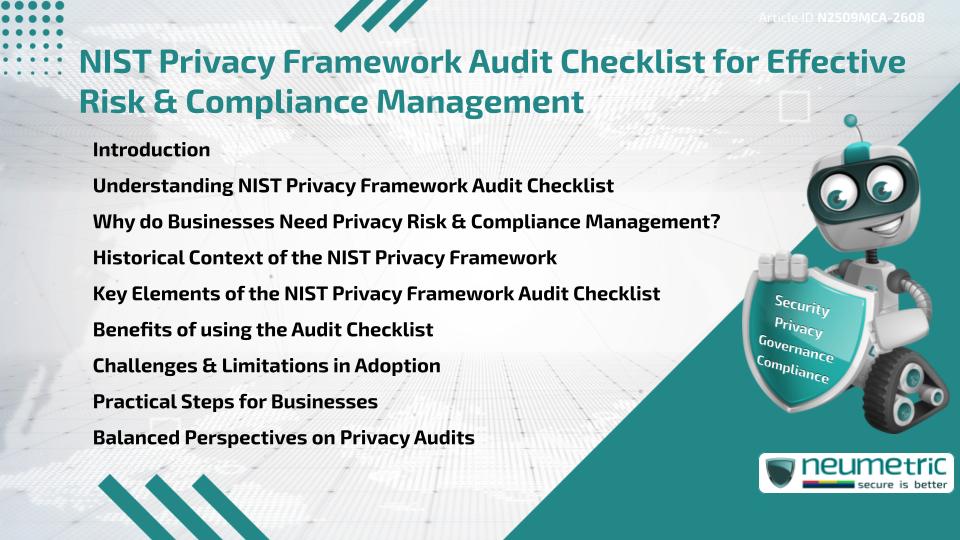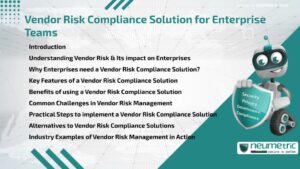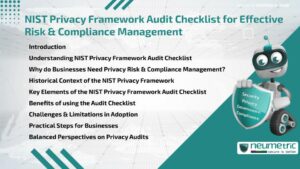Table of Contents
ToggleIntroduction
The NIST Privacy Framework Audit Checklist provides businesses with a structured tool to assess & manage Privacy Risks while ensuring Compliance with laws & regulations. Created by the National Institute of Standards & Technology [NIST], this Checklist helps Organisations evaluate their Privacy programs, identify Gaps & implement Controls that safeguard Personal Information. For enterprises, it serves as both a roadmap & an Accountability tool, promoting Trust, Transparency & effective Risk Management.
Understanding NIST Privacy Framework Audit Checklist
At its core, the NIST Privacy Framework Audit Checklist translates the principles of the NIST Privacy Framework into actionable items. It enables Organisations to systematically review how well they integrate Privacy into products, services & operations. Much like a Financial Audit uncovers inconsistencies in accounts, this Checklist reveals weaknesses in Privacy practices & offers opportunities for improvement.
Why do Businesses Need Privacy Risk & Compliance Management?
In today’s data-driven economy, managing Privacy Risks is critical. Data Breaches, Regulatory fines & Reputational damage can result from poorly managed Privacy programs. The NIST Privacy Framework Audit Checklist helps businesses establish Accountability while aligning with Global Standards such as the GDPR & CCPA. By embedding Privacy into everyday processes, Organisations build Resilience & strengthen Consumer Trust.
Historical Context of the NIST Privacy Framework
The NIST Privacy Framework was introduced as a voluntary tool to help businesses manage Privacy Risks consistently. Just as the NIST Cybersecurity Framework became a global benchmark for protecting systems, the Privacy Framework extends this philosophy to Personal Data. Over time, it has become a reference point for enterprises aiming to demonstrate responsible data stewardship & comply with evolving regulations.
Key Elements of the NIST Privacy Framework Audit Checklist
The NIST Privacy Framework Audit Checklist typically covers the following areas:
- Governance: Policies, leadership Accountability & Organisational culture for Privacy.
- Data Mapping: Identifying what data is collected, processed & shared.
- Risk Assessment: Evaluating Risks to individuals & Organisations from data practices.
- Controls & Safeguards: Technical & Organisational measures to mitigate Risks.
- Monitoring & Evaluation: Regular Reviews to ensure ongoing effectiveness.
- Incident Response: Procedures for handling Privacy violations & Breaches.
These elements give businesses a practical tool to transform high-level Framework principles into measurable actions.
Benefits of using the Audit Checklist
Businesses gain significant advantages from adopting the NIST Privacy Framework Audit Checklist:
- Improved Compliance with Privacy regulations
- Enhanced Accountability & Governance structures
- Better ability to detect & reduce Risks proactively
- Increased trust with Customers, Regulators & Partners
- Cost savings from preventing breaches & penalties
Just as health inspections ensure food safety, this Checklist ensures data practices remain safe, consistent & trustworthy.
Challenges & Limitations in Adoption
Despite its value, businesses may encounter challenges when adopting the NIST Privacy Framework Audit Checklist:
- Lack of Privacy expertise within the Organisation
- Resource constraints in developing & monitoring Privacy programs
- Complexity in adapting the Checklist to diverse industries & Global Standards
- Potential resistance from teams focused on rapid innovation
These challenges highlight the need for leadership support & ongoing education to embed Privacy as a cultural priority.
Practical Steps for Businesses
Organisations can take the following steps to adopt the NIST Privacy Framework Audit Checklist effectively:
- Train staff on Privacy principles & the Framework’s functions
- Conduct a baseline Audit to identify strengths & weaknesses
- Develop an action plan with clear milestones & Accountability
- Integrate Audit Reviews into ongoing Governance processes
- Engage Third Party Auditors for objective evaluation
This approach mirrors Quality Management audits, ensuring consistent practices across the Organisation.
Balanced Perspectives on Privacy Audits
While the NIST Privacy Framework Audit Checklist is a valuable tool, some critics argue that voluntary frameworks may lack enforcement power. Others caution that Audits may add administrative burden without guaranteeing outcomes. Still, many experts agree that a structured Checklist improves Accountability & fosters a culture of Trust. The key lies in tailoring the Checklist to business needs while maintaining commitment to responsible data practices.
Takeaways
- The NIST Privacy Framework Audit Checklist helps businesses assess Privacy Risks & Compliance.
- It transforms the NIST Privacy Framework into actionable measures.
- Key elements include Governance, Data Mapping, Risk Assessment & Incident Response.
- Benefits include stronger Compliance, Trust & Risk Mitigation.
- Challenges exist, but practical steps make adoption achievable.
FAQ
What is the NIST Privacy Framework Audit Checklist?
It is a structured tool that helps Organisations evaluate & manage Privacy Risks based on the NIST Privacy Framework.
Why is the Checklist important for businesses?
It ensures Accountability, strengthens Compliance & builds Trust by embedding Privacy into business practices.
What areas does the Checklist cover?
It covers Governance, Data Mapping, Risk Assessment, Safeguards, Monitoring & Incident Response.
Is the Checklist mandatory?
No, it is voluntary, but many Organisations use it to align with Best Practices & Regulatory expectations.
How does it relate to Compliance laws like GDPR or CCPA?
The Checklist helps Organisations align their practices with global Privacy laws & Regulatory requirements.
What challenges might businesses face when adopting it?
Challenges include lack of expertise, resource constraints & cultural resistance within Organisations.
Can Small Businesses adopt the Checklist?
Yes, the Checklist is scalable & adaptable, making it suitable for businesses of all sizes.
How often should audits be performed?
Audits should be conducted regularly, at least annually & more frequently in high-Risk or highly regulated industries.
Need help for Security, Privacy, Governance & VAPT?
Neumetric provides organisations the necessary help to achieve their Cybersecurity, Compliance, Governance, Privacy, Certifications & Pentesting needs.
Organisations & Businesses, specifically those which provide SaaS & AI Solutions in the Fintech, BFSI & other regulated sectors, usually need a Cybersecurity Partner for meeting & maintaining the ongoing Security & Privacy needs & requirements of their Enterprise Clients & Privacy conscious Customers.
SOC 2, ISO 27001, ISO 42001, NIST, HIPAA, HECVAT, EU GDPR are some of the Frameworks that are served by Fusion – a SaaS, multimodular, multitenant, centralised, automated, Cybersecurity & Compliance Management system.
Neumetric also provides Expert Services for technical security which covers VAPT for Web Applications, APIs, iOS & Android Mobile Apps, Security Testing for AWS & other Cloud Environments & Cloud Infrastructure & other similar scopes.
Reach out to us by Email or filling out the Contact Form…





